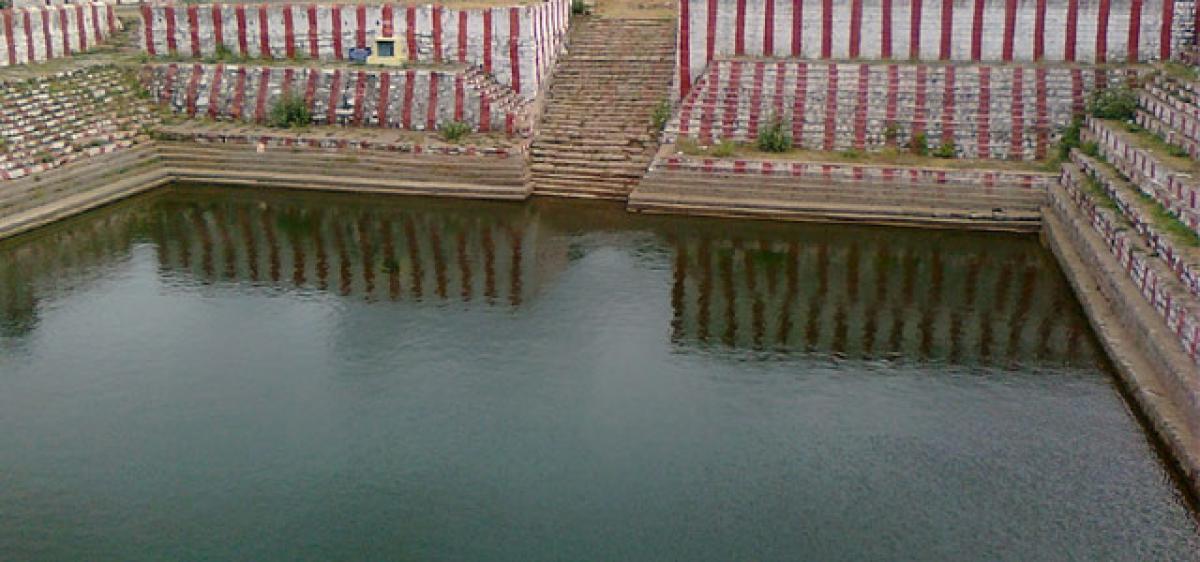Live
- Mohan Babu’s look as Mahadeva Shastri from ‘Kannappa’ grabs attention
- A soulful song from ‘Bachhala Malli’ gets unveiled
- ‘Pushpa-2: The Rule’ creates nationwide buzz with electrifying updates
- Meta Removes Over Two Million Scam Accounts Tied to Pig Butchering
- CERT-In Warns iPhone Users: Update to iOS 18.1.1 Now to Avoid Hacking
- Rana Daggubati’s Show gets huge applause at 55th IFFI
- Jana Sena MLA Pulaparthi Ramanjaneyulu Elected as PAC chairman
- Stage set for counting of votes for Jharkhand Assembly elections
- MLA Sri Ganesh Engages ASHA Workers and Resource Persons in Caste Census Meeting
- Supreme Court verdict on validity of Preamble modification in 1976 likely on November 25
Just In

The Pushkarini (temple tank) of the famous Lord Govindaraja Swamy shrine here which was once filled with water is now remaining parched miffing the ardent devotees visiting the shrine who are keen on at least sprinkling the holy water on their head if not taking a holy dip before offering prayers to the Lord.
Tirupati: The Pushkarini (temple tank) of the famous Lord Govindaraja Swamy shrine here which was once filled with water is now remaining parched miffing the ardent devotees visiting the shrine who are keen on at least sprinkling the holy water on their head if not taking a holy dip before offering prayers to the Lord.
Pushkarini is an integral and inseparable part of Hindu temples and is mainly meant for providing sacred water for performing daily rituals in the shrine including Abhishekam (celestial bath) of the deities, making Prasadams and also for the devotees to have a holy dip before visiting the shrine to offer prayers to the deity.
The using of Pushkarini water for day to day rituals in the temples ceased long back in almost all the temples after the waters in the temple tanks got contaminated and turned unfit for human consumption.
But the devotees have been taking a holy dip or sprinkling the waters on their heads before temple entry as a token of their reverence and following the age-old tradition.
Here in the case of the 12th century temple of Lord Govindaraja Swamy, elder brother of Lord Venkateswara, the devotees have no choice except simply viewing the sprawling tank with beautifully well laid steps on four sides and artistically built stone mandapam in the middle of the tank, wondering on its downfall of looking barren with not a drop of water.
However, the drying up of the tank was not sudden but was the result of the steady changes swiftly ushered in the temple city following its rapid growth, thanks to the manifold increase in the pilgrim population visiting Tirumala.
The natural springs sustaining the tank water dried up following the mushrooming of high rise buildings more so hotels and lodges which consume more water, around the temple tank, resulting in the groundwater level depleting to about 200 ft below and severing of the flow from streams from the hill slopes into to various ponds here due to the expansion of the city resulting in the ponds disappearing and the temple tank too drying up.
A TTD water works official revealed that it is very expensive to maintain water in the temple tank as it requires pumping water from outside and cleaning it regularly.
Further, Govindaraja Swamy Pushkarini is located in the thickly populated and busiest area near Railway station and bus stand in the city it is very difficult to guard the tank waters remain clean.
“So, we ensure water only to conduct the annual festival like Teppotsavam (float festival) and later the tank is left dry after the seepage of the water pumped for the special occasion of float festival,” the water works official said.
Kuppa Siva Subramaya Avadhani, TTD Veda Vignanpeetam Principal said, the devotees have to reconcile with the change of times while observing that the sorry state of Pushkarini was due to Kala Prabhavam coming in the way of following the age old practice like taking holy dip before offering prayers in the temple.

© 2024 Hyderabad Media House Limited/The Hans India. All rights reserved. Powered by hocalwire.com







